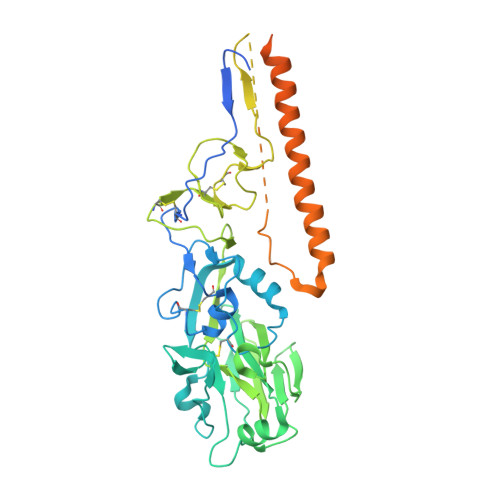An epitope-enriched immunogen expands responses to a conserved viral site.
Caradonna, T.M., Ronsard, L., Yousif, A.S., Windsor, I.W., Hecht, R., Bracamonte-Moreno, T., Roffler, A.A., Maron, M.J., Maurer, D.P., Feldman, J., Marchiori, E., Barnes, R.M., Rohrer, D., Lonberg, N., Oguin 3rd, T.H., Sempowski, G.D., Kepler, T.B., Kuraoka, M., Lingwood, D., Schmidt, A.G.(2022) Cell Rep 41: 111628-111628
- PubMed: 36351401
- DOI: https://doi.org/10.1016/j.celrep.2022.111628
- Primary Citation of Related Structures:
7UMM - PubMed Abstract:
Pathogens evade host humoral responses by accumulating mutations in surface antigens. While variable, there are conserved regions that cannot mutate without compromising fitness. Antibodies targeting these conserved epitopes are often broadly protective but remain minor components of the repertoire. Rational immunogen design leverages a structural understanding of viral antigens to modulate humoral responses to favor these responses. Here, we report an epitope-enriched immunogen presenting a higher copy number of the influenza hemagglutinin (HA) receptor-binding site (RBS) epitope relative to other B cell epitopes. Immunization in a partially humanized murine model imprinted with an H1 influenza shows H1-specific serum and >99% H1-specific B cells being RBS-directed. Single B cell analyses show a genetically restricted response that structural analysis defines as RBS-directed antibodies engaging the RBS with germline-encoded contacts. These data show how epitope enrichment expands B cell responses toward conserved epitopes and advances immunogen design approaches for next-generation viral vaccines.
- Ragon Institute of MGH, MIT and Harvard, Cambridge, MA 02139, USA.
Organizational Affiliation:




















